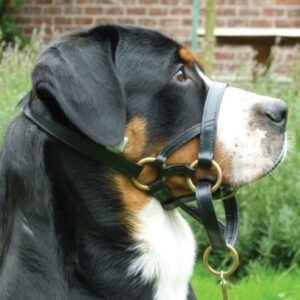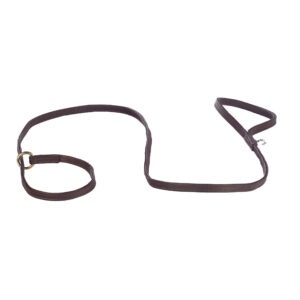Are Slip Leads Good For Dogs That Pull?
Every dog owner wants their walks to be enjoyable, with an easy rhythm between you and your dog, with no pulling, no tugging, just a calm, shared adventure. But if your dog pulls on the lead, even a short walk can quickly become a bit of a battle.
That’s often when owners start exploring different tools, including slip leads. They’re simple, popular, and commonly used in certain training circles, but are slip leads the right choice for a dog that pulls?
Let’s examine slip leads in more detail, how they work, and whether they’re a suitable option for your dog, especially if pulling is involved.
What Is A Slip Lead?
A slip lead is a one-piece lead and collar combination. There’s no buckle, clasp, or clip. Instead, the lead forms a loop that slips over your dog’s head and tightens when your dog pulls.
As soon as the tension is released, the lead loosens again. It’s quick to put on and simple to use and is commonly seen in vet clinics, dog rescues, and dog shows.
The key idea behind a slip lead is that it offers immediate feedback; if the dog pulls, it feels gentle pressure. When it stops pulling, the pressure is released. That sounds straightforward, but the experience can vary greatly depending on the dog, the handler, and the context.

Why Some Trainers Use Slip Leads
There’s a reason professional handlers often favour slip leads in short-term or high-turnover environments. They’re easy to pop on and off and useful in fast-paced settings like vet visits or dog rescues. They’re also lightweight and compact, making them a convenient option for transport or quick control.
Some trainers also use them in structured training sessions, where they can give a quick, controlled correction to signal a behaviour change. In these cases, the slip lead is used with careful timing and gentle handling as part of a broader training approach.
However, a slip lead may not always be the most suitable choice for everyday walking, especially with a dog that pulls.
Slip Leads and Pulling: A Closer Look
Here’s the heart of the matter. Slip leads are designed to apply pressure when the dog pulls. For a dog that already pulls on the lead, this can sometimes make things worse, not better.
Many dogs don’t understand pressure without proper training and consistent reinforcement. They keep pulling, the lead keeps tightening, resulting in discomfort and very little progress.
There’s also the issue of pressure on the neck. Dogs that pull hard or lunge can strain their throat significantly, leading to irritation, coughing, or even longer-term damage to the trachea or neck muscles. This is primarily a concern for smaller breeds or brachycephalic dogs (those with shorter snouts), who are already more vulnerable in this area.
That’s not to say slip leads are inherently harmful, but they rely heavily on timing, technique, and a dog already well-versed in loose-lead walking cues. Without those pieces, the slip lead can become a source of confusion and stress.

Are There Better Options for Dogs That Pull?
If pulling is a regular feature on your walks, other tools are often more effective and more comfortable for you and your dog.
A well-fitted headcollar, for example, gives you gentle but precise control of your dog’s direction. Rather than relying on strength or correction, a headcollar allows you to guide your dog’s head, and where the head goes, the body follows. This can be particularly helpful for larger or more enthusiastic dogs or owners who want more control without relying on physical force.
Dogmatic’s headcollars are designed with your dog’s comfort in mind. They don’t twist, ride into the eyes, or slide around the face. Instead, they sit securely and comfortably, allowing you to manage pulling calmly and kindly.
Of course, consistent training is the foundation of any good walking behaviour. Tools can help, but they work best alongside positive reinforcement, clear cues, and patient guidance.
Teaching your dog that staying near you brings rewards (like praise, treats, or sniff breaks) goes a long way in building the habits you want to see on every walk.
Are Slip Leads Ever a Good Option?
Slip leads can have their place. Dogs already trained to walk nicely on a lead can be a convenient option for short trips or quick handling. They’re also helpful in controlled environments where the handler has experience and the goal is clear communication over a brief session.
However, they’re not typically recommended as a long-term solution for dogs that pull. For these dogs, a headcollar, used alongside positive training techniques, will often deliver better results in a more comfortable, confidence-building way.

Helping Your Dog Learn to Walk Calmly
Whatever tool you choose, the goal is the same: a happy dog walking calmly beside you, both enjoying the journey. The tool should support that experience, not create conflict or confusion.
If your dog pulls, consider the root of the behaviour. Is it excitement? Distraction? Nervousness? The more you understand what’s driving your dog’s actions, the better you can guide them gently toward more balanced walks.
Don’t be afraid to seek advice. Working with a qualified, reward-based trainer can make a difference, especially if you’re unsure which tools or techniques are right for your dog.
Kind, Calm, and in Control. Find Something That Works For You With Dogmatic
At Dogmatic, walking your dog should be one of the best parts of your day, not a battle of wills. That’s why we design tools that support kind, practical training and help you build a stronger bond with your dog.
Whether you choose a traditional collar, a headcollar, or another walking aid, the most important thing is that it works for both of you, with comfort, safety, and trust at the heart of it.
Slip leads may suit some dogs in some situations, but for dogs that pull, there are often gentler and more effective ways to guide them. With the right approach, fit, and patience, your dog can learn to walk calmly and confidently, making every walk a pleasure from start to finish.
